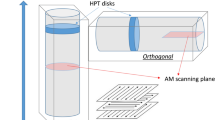Abstract
In a previous study, we developed a novel in situ analysis and observation system that allows for simultaneous synchrotron X-ray diffraction (XRD) and optical observations of a frictional surface. This in situ system was used to investigate the scuffing phenomena of SUJ2 bearing steel (AISI 52100); characteristic surface deteriorations occurred during the scuffing process, including plastic flow, heat-spot formation, austenite transformation, and a decrease in the width of the XRD peaks (indicating a decrease of dislocations and strain). These surface deteriorations are not observed during normal wear, hence it is possible that they cause catastrophic wear during the scuffing of steel. In this study, to elucidate the scuffing mechanism of steel, we focused on the following two points: (1) whether the above surface deteriorations are unique to SUJ2 steel or whether they occur in general steels as well, and (2) the extent to which these surface deteriorations contribute to the wear amount. To achieve these objectives, we performed scuffing tests on four types of steel using the previously developed in situ system. In particular, we focused on the first stage of the scuffing process. The present test results suggest that these surface deteriorations also occur in general steels, and that plastic flow and heat-spot formation, which originate from the same phenomenon, are the dominant contributors to the wear amount during the scuffing of steel. Furthermore, the wear amount per unit plastic flow appears to be independent of steel composition.















Similar content being viewed by others
References
Dyson, A.: Scuffing—a review. Tribol. Int. 8(2), 77–87 (1975)
Dyson, A.: Scuffing—a review: part 2: the mechanism of scuffing. Tribol. Int. 8(3), 117–122 (1975)
Ludema, K.C.: A review of scuffing and running-in of lubricated surfaces, with asperities and oxides in perspective. Wear 100(1–3), 315–331 (1984)
Bowman, W.F., Stachowiak, G.W.: A review of scuffing models. Tribol. Lett. 2(2), 113–131 (1996)
Rogers, M.D.: Metallographic characterisation of transformation phases on scuffed cast-iron diesel engine components. Tribology 2(2), 123–127 (1969)
Rogers, M.D.: The mechanism of scuffing in diesel engines. Wear 15(2), 105–116 (1970)
Torrance, A.A., Cameron, A.: Surface transformations in scuffing. Wear 28(3), 299–311 (1974)
Rogers, H.C.: Adiabatic plastic deformation. Annu. Rev. Mater.Sci. 9(1), 283–311 (1979)
Hershberger, J., Ajayi, O.O., Zhang, J., Yoon, H., Fenske, G.R.: Formation of austenite during scuffing failure of SAE 4340 steel. Wear 256(1–2), 159–167 (2004)
Ajayi, O.O., Hersberger, J.G., Zhang, J., Yoon, H., Fenske, G.R.: Microstructural evolution during scuffing of hardened 4340 steel—implication for scuffing mechanism. Tribol. Int. 38(3), 277–282 (2005)
Hershberger, J., Ajayi, O.O., Zhang, J., Yoon, H., Fenske, G.R.: Evidence of scuffing initiation by adiabatic shear instability. Wear 258(10), 1471–1478 (2005)
Ajayi, O.O., Lorenzo-Martin, C., Erck, R.A., Fenske, G.R.: Scuffing mechanism of near-surface material during lubricated severe sliding contact. Wear 271(9–10), 1750–1753 (2011)
Han, J.M., Zhang, R., Ajayi, O.O., Barber, G.C., Zou, Q., Guessous, L., Schall, D., Alnabulsi, S.: Scuffing behaviour of gray iron and 1080 steel in reciprocating and rotational sliding. Wear 271(9–10), 1854–1861 (2011)
Ajayi, O.O., Lorenzo-Martin, C., Erck, R.A., Fenske, G.R.: Analytical predictive modeling of scuffing initiation in metallic materials in sliding contact. Wear 301(1–2), 57–61 (2013)
Enthoven, J.C., Cann, P.M., Spikes, H.A.: Temperature and scuffing. Tribol. Trans. 36(2), 258–266 (1993)
Yagi, K., Ebisu, Y., Sugimura, J., Kajita, S., Ohmori, T., Suzuki, A.: In situ observation of wear process before and during scuffing in sliding contact. Tribol. Lett. 43(3), 361–368 (2011)
Li, H., Yagi, K., Sugimura, J., Kajita, S., Shinyoshi, T.: Role of wear particles in scuffing initiation. Tribol. Online 8(5), 285–294 (2013)
Matsuzaki, Y., Yagi, K., Sugimura, J.: In situ fast and long observation system for friction surfaces during scuffing of steel. Wear 386–387, 165–172 (2017)
Miyajima, M.,. Kitamura, K., Matsumoto, K.: In situ raman tribometry for the formation and removal behavior of FeS2 tribofilm in the scuffing process. Tribol. Online 11(2), 382–388 (2016)
Kajita, S., Yagi, K., Izumi, T., Koyamachi, J., Tohyama, M., Saito, K., Sugimura, J.: In situ X-ray diffraction study of phase transformation of steel in scuffing process. Tribol. Lett. 57(1), 1–11 (2015)
Yagi, K., Kajita, S., Izumi, T., Koyamachi, J., Tohyama, M., Saito, K., Sugimura, J.: Simultaneous synchrotron X-ray diffraction, near-infrared, and visible in situ observation of scuffing process of steel in sliding contact. Tribol. Lett. 61(19), 1–16 (2016)
Japan Institute of Metals and Materials: Metal Data Book. Maruzen, Tokyo (1974) (in Japanese)
Hirose, Y.: TOYOTA beamline BL33XU. In: SPring-8 Research Frontiers 2009, p. 170 (2010)
Nonaka, T., Dohmae, K., Hayashi, Y., Araki, T., Yamaguchi, S., Nagai, Y., Hirose, Y., Tanaka, T., Kitamura, H., Uruga, T., Yamazaki, H., Yumoto, H., Ohashi, H., Goto, S.: Toyota Beamline (BL33XU) at SPring-8. In: Proceedings of the 12th International Conference on Synchrotron Radiation Instrumentations (2015)
Mohrbacher, H., Blanpain, B., Celis, J.P., Roos, J.R., Stals, L., Van Stappen, M.: Oxidational wear of TiN coatings on tool steel and nitrided tool steel in unlubricated fretting. Wear 188, 130–137 (1995)
Fouvry, S., Kapsa, P., Vincent, L.: Quantification of fretting damage. Wear 200, 186–205 (1996)
Acknowledgements
The experiments in this study were performed at the Toyota beamline BL33XU of SPring-8 with the approval of the Japan Synchrotron Radiation Research Institute (JASRI) (Proposal Nos. 2013B7021, 2014B7021, and 2015B7021).
Author information
Authors and Affiliations
Corresponding author
Rights and permissions
About this article
Cite this article
Izumi, T., Yagi, K., Koyamachi, J. et al. Surface Deteriorations During Scuffing Process of Steel and Analysis of Their Contribution to Wear Using In Situ Synchrotron X-Ray Diffraction and Optical Observations. Tribol Lett 66, 120 (2018). https://doi.org/10.1007/s11249-018-1062-6
Received:
Accepted:
Published:
DOI: https://doi.org/10.1007/s11249-018-1062-6



